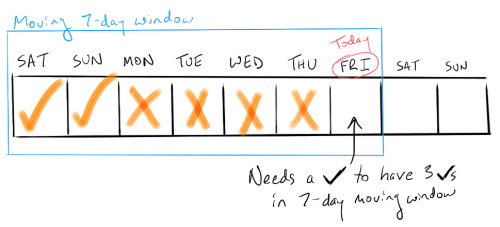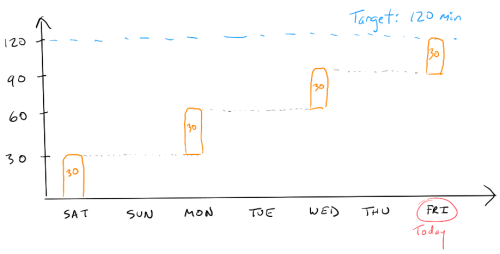Matt's Roof Garden
Powered by 🌱Roam GardenSuccessful habits through smoothly ratcheting targets
Author::Person/Andy Matuschak
Topic::habit Spaced Repetition productivity habit goals
Tags:: article
Summary::
Content::
Adopting new habits is hard! What a shame: New Year’s resolutions could represent such a bright spark of optimism. Instead, they’re a clichéd punchline on the futility of human will. Certainly, my own past attempts have deserved those jokes!
But in 2017, I shifted strategies and successfully built four new habits (of five attempted): piano practice, internetless mornings, carbless workdays, and meditation. In past years I’d feel lucky if I built just one new habit! I’d like to share my approach: smoothly ratcheted targets, in moving weekly windows, with teeth. Before I unpack that, let’s cover some background.
Most people seem to attempt habits informally, deploying only hope and good intentions. Alas: that doesn’t work very reliably—or at least it certainly doesn’t for me! More serious approaches typically employ one of two formal strategies : chaining, or scheduling.
Chaining is basically “cold turkey” habit adoption: start doing it every day—and don’t break your chain! This approach combines an incentive system (maintaining streaks) with an adoption system (“start doing it every day!”). Streaks can offer a powerful incentive for an established habit, but they do little for fragile new habits. It’s the adoption strategy that really matters initially, yet “start doing it every day!” is a brittle—and, to me, unrealistic—adoption strategy.
Seeing that daily compliance is too ambitious, others try scheduling their habits: let’s play piano on Monday and Thursday nights! In my experience, this works intermittently, but it’s ultimately too brittle in the face of a life I’d want to live. Say Thursday rolls around, and over lunch, a friend invites me to an interesting evening event. No problem: the spirit of my goal would be satisfied if I practiced over the weekend instead. But because I’m depending on explicit scheduling to trigger practice, now I have to actually move a calendar event. That’s high-friction, so instead I just accidentally drop the ball until next Monday. Others tell me this matches their experience.
I’ve found that to reliably adopt a habit, I need a strategy that bends, not breaks, while still holding me accountable over time. It should supply pressure smoothly and flexibly.
So now I start each habit with a low weekly goal: e.g. meditate once per week, any day. That bar is low enough that I don’t have to schedule it or do anything special. Once that stabilizes, I ratchet up the target frequency.
This sounds pretty simple, but I found there are some important subtleties which have made implementation tricky. I’ll outline the key issues now before describing my own solution.
Smooth pressure demands moving windows: make every day doable
Being human, I’d often put off my habits to the end of the week. That worked reasonably well until some goals targeted three days per week. Then it was way too easy to end up in this trap:

To avoid trapping myself, I’d have to perform a sort of time traveling lookahead each day. “Will I accidentally back myself into a corner if I don’t do the habit today?” It felt like my system had pointy edges I had to be careful of.
I’ve found that smooth pressure demands we ensure that every day is doable. There should never be an “impossible” day like the one I illustrated above!
We can make that happen if we use moving weekly windows instead of calendar weeks. Every day, look back a week and make sure you hit your goal within that 7-day window. A moving weekly window prevents us from reaching the situation I illustrated above because on Friday, it would have made clear that we needed a check:

With a moving weekly window, I can tackle habits on whichever days seem best, but I always get a clear warning when today is a “jeopardy” day. I don’t have to look into the future to figure out whether I’ll be able to hit my goal.
Smooth ratcheting and flexibility through fine-grained targets
When it’s time to ratchet up the target, adding one day per week to a habit can feel like a huge change! I find that fine-grained values work better when possible. For my piano practice, I don’t use “numbers of days practiced per week”: I use “number of minutes practiced per week.” I barely notice adding ten minutes per week to the goal, so I can smoothly ratchet up my target.
These fine-grained values also offer more flexibility. Say I want two hours a week of practice. That could be two big weekend practice sessions, or 15–20 minutes per day, or a 1-hour session with a couple smaller sessions. All those configurations hit my target, but the flexibility helps me maintain specific goals in the face of my shifting daily interest and availability.


Give the goals teeth
Accountability is powerful! Certainly, in the workplace, I find I achieve my goals more reliably when I have some real skin in the game. The same appears to be true for personal habits.
There are lots of ways to arrange accountability; I suspect this is probably the least important specific of my approach. It’s probably only important that there be some consequence to slipping, or maybe some incentive for not slipping. Maybe a “don’t break the chain!” incentive would be enough for my habits at this point.
I’ve arranged to lose a small amount of money ($10–$30) when I miss a goal. I only had to pay a couple times in 2017. It’s strange how effective that threat is once a habit is reasonably stable. I’m fortunate that this isn’t an amount of money I’d stress about, but I feel so indignant about losing money for stupid reasons that the threat keeps me on track. I’d probably feel similar motivation from some mechanism which loudly texts my friends when I fail.
Implementing the habit goals
I’m not a “Quantified Self” adherent, and I’m not interested in graphs or an elaborate dashboard for my habits. But the mechanism I’ve described is complicated enough that a tool really helps implementation. I really only need a small piece of software to tell me “hey! you need to do X habit today!”—and to hold me accountable if I don’t. Occasionally I want to ask a hypothetical like “if I don’t do it today, what would that force the next few days to look like?”
The best tool I’ve found for implementing this strategy is Beeminder, which happily handles all the nuances I’ve described above. Unfortunately, I always have to add an asterisk when I mention it: Beeminder’s great; it’s truly changed my life; yet it’s the highest-friction, least-polished software I regularly use. Most of my friends who’ve tried it can’t get past its interface. This is a shame, but I encourage you, dear reader, to push past the design problems and give it a try anyway.

I’ve looked at many alternatives. Some are very nicely designed! Unfortunately, all are missing at least one of the attributes I described above; in particular, I haven’t found another with the running window, and most lack an accountability mechanism.
So far, I’ve successfully restrained myself from building my own tool. That’s a dangerous yak to shave! But if you find another tool which can implement the behaviors I describe, please do let me know.
I’m about to start a few new habits in 2018, and I’m excited because after last year’s success, I think they might actually stick. Best of luck with your own habits, and happy new year!